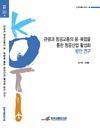Basic Report

RESEARCH
KOTI - Korea Transport institute
Promotion of Aviation Industry through Converging and Integrating Tourism and Air Transportation
- Date
October 31 2012
- Page(s)
page(s)

Many people are reminded of an airplane travel whenever they think of overseas trips. It is because air transport is one of the key transportations in the sightseeing market. On the other hand, like people dreaming of traveling to Kenya in Africa once the new air route to Kenya has been developed, a new tour market can arise from the development of new air routes. These examples show the obvious facts that air transport is closely connected with tourism.
This means that the air transport market is partially based on the tour market and the variation of air transport market strongly influences the tourism industry. Therefore, the recent social and economic environment changes such as globalization, population growth, aging and income level growth offers opportunities for new market expansion of both tour and air transport.
Meanwhile, the air transport market change in demand for tourism and its creation of demand have occurred steadily and complexly. In the case of South Korea, as demand for domestic air transport decreases, plans for the creation of demand for air transport through tourism is being considered to improve the low rate of utilization at many regional airports. Construction of small aerodromes reflecting the demand for tourism is also being carried out. However, integrated plans for both industries have been incomplete so far. Therefore, the purpose of this study is to develop an air transport demand forecasting model reflecting the related determinants of tour and air transport demand and to establish a tour and air transportation convergence strategy and policy suggestion in order to revitalize the aviation industry, based on analysis of the relationship between tour and air transport.
Concretely, in order to grasp the relationship between tour and aviation which is the basis of this study, the overviews for domestic and foreign trends of tour and aviation were conducted in various aspects. Then, through proper examination and an analysis in quantitative correlation, research was conducted to understand the relation between the tour and aviation market at pre-development stages of specific models and plans. Also, based on this fundamental knowledge, the factors for the demand for both the tour and aviation market were examined including cause-and-effect relationships between individual factors. Following this, main factors were derived by comparative reviews of demand as dependent variables. Conclusively, a demand forecasting model was calculated and verified considering the results and the purpose of this study. Moreover, existing policies were reviewed and case studies on domestic regional airports and airports in other nations were conducted. Lastly, this study suggested strategies and countermeasures for policy convergence on tour and air transport, which were evaluated in terms of demands.
Provided that study results could contribute efforts to the effective revitalization of the tour and aviation industry, not only does it play a role in job creation and its national interest accordingly, but also the enhancement of national brand is expected
This means that the air transport market is partially based on the tour market and the variation of air transport market strongly influences the tourism industry. Therefore, the recent social and economic environment changes such as globalization, population growth, aging and income level growth offers opportunities for new market expansion of both tour and air transport.
Meanwhile, the air transport market change in demand for tourism and its creation of demand have occurred steadily and complexly. In the case of South Korea, as demand for domestic air transport decreases, plans for the creation of demand for air transport through tourism is being considered to improve the low rate of utilization at many regional airports. Construction of small aerodromes reflecting the demand for tourism is also being carried out. However, integrated plans for both industries have been incomplete so far. Therefore, the purpose of this study is to develop an air transport demand forecasting model reflecting the related determinants of tour and air transport demand and to establish a tour and air transportation convergence strategy and policy suggestion in order to revitalize the aviation industry, based on analysis of the relationship between tour and air transport.
Concretely, in order to grasp the relationship between tour and aviation which is the basis of this study, the overviews for domestic and foreign trends of tour and aviation were conducted in various aspects. Then, through proper examination and an analysis in quantitative correlation, research was conducted to understand the relation between the tour and aviation market at pre-development stages of specific models and plans. Also, based on this fundamental knowledge, the factors for the demand for both the tour and aviation market were examined including cause-and-effect relationships between individual factors. Following this, main factors were derived by comparative reviews of demand as dependent variables. Conclusively, a demand forecasting model was calculated and verified considering the results and the purpose of this study. Moreover, existing policies were reviewed and case studies on domestic regional airports and airports in other nations were conducted. Lastly, this study suggested strategies and countermeasures for policy convergence on tour and air transport, which were evaluated in terms of demands.
Provided that study results could contribute efforts to the effective revitalization of the tour and aviation industry, not only does it play a role in job creation and its national interest accordingly, but also the enhancement of national brand is expected